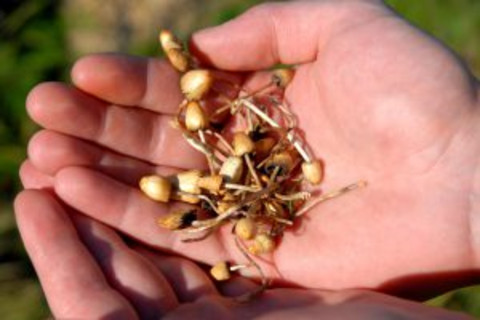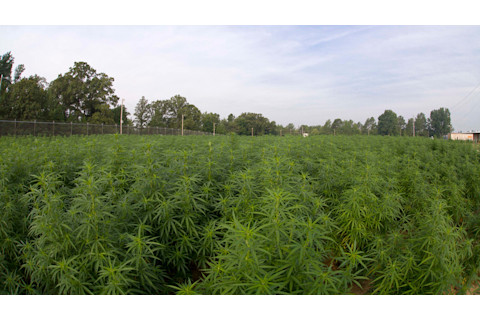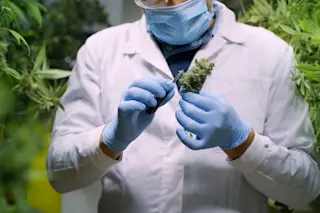Public interest in the science of powerful psychoactive drugs is at an-all-time, er, high. Evidence for the therapeutic benefits of marijuana, MDMA, psilocybin and more is growing, based on a resurgence of scientific interest in studying these compounds.
But many of these drugs are strictly banned by the federal government, and those caught with them on the street can face steep fine and felony prison time. So where are researchers getting the drugs for their studies?
The short answer is, in many cases, the federal government. The National Institutes on Drug Abuse (NIDA) has an extensive catalog of drugs that researchers can order from, including heroin, cannabis, ibogaine and even carfentanil, a drug often used to sedate elephants.
Getting to the point where you can place an order for heroin to Uncle Sam is difficult, though, and it involves spools of red tape, background checks and rigorous protocols. But a small cohort of researchers remains dedicated to exploring the healing potential of currently illegal drugs, despite the often daunting bureaucratic hoops.
“It is likely that several drugs currently classified under Schedule I have important therapeutic potential,” a group of New York doctors wrote in the American Journal of Bioethics in 2016. “The Catch 22 … is that the classification of drugs as Schedule I amounts to an unsurmountable barrier to research.”
Drug Research a Trip
Many of the hurdles to legitimate drug research stem from the Controlled Substances Act, signed into law in 1970 by President Richard Nixon. This legislation places drugs into different categories called “schedules” based on their medical uses and risk for abuse. Drugs in the Schedule I category are considered to have no medical applications whatsoever and carry a high risk for abuse. It includes substances like heroin, peyote, LSD and, of course, marijuana. Drugs like cocaine, methamphetamine, and fentanyl are in Schedule II — that’s because these drugs have accepted medical uses. Alcohol and tobacco, two of the most popular drugs in America, are not scheduled.
If scientists want to study Schedule I drugs, it’s remarkably more difficult than substances in lower categories.
It wasn’t always that way. Psychedelic research used to be relatively easy: simply give them to patients and record the results.
Between 1961 and 1963, Harvard University researchers led by Timothy Leary gave 32 inmates at the maximum security Concord State Prison psilocybin, the active ingredient in magic mushrooms. (They found it led to fewer instances of prisoners returning to the criminal justice system after release and these results were replicated in 2014.) Leary and others conducted a number of similar experiments with psychedelics around this time.
But lax regulation of scientific studies has also led to atrocities like the Tuskegee syphilis experiment, a 40-year study of African-American men with syphilis. While the patients were given free medical care and food, the researchers lied to patients about the true intentions of their research and withheld medical treatment that would have cured their illness.
Getting Permission to Get People High
The National Research Act of 1974, also signed by Nixon, aimed to prevent something like the Tuskegee experiment from happening again. It requires studies to demonstrate the public benefits of biomedical and behavioral research to an institutional review board (IRB), accounting for the risks to patients and ensuring they are treated with respect and justice.
Getting permission from an IRB to give people a psychedelic drug has not historically been easy. The process can be so arduous and expensive that some universities or labs may not even bother.
But if you do design a study around a Schedule I substance, and it does get approved by an IRB, the next hurdle is getting permission from the Drug Enforcement Administration (DEA). When Bryan Roth, a pharmacology professor at UNC Chapel Hill Medical School, wanted to study how LSD binds in the brain, he first had to get a Schedule I license. “Basically you apply to the DEA and then fill out much paperwork documenting how and why you are proposing to study LSD, how much material you will possess and how it will be stored and protected from diversion,” Roth explains. “It took in total around two years to finally get the license after much paperwork back and forth and a site visit by the DEA.”
Despite growing enthusiasm among the general public surrounding psychedelics, Roth says that most scientists still aren’t interested in studying these drugs. Schedule I barriers play a role, but a bigger issue to Roth is that “when grants are reviewed, there is typically no one on the review panel who studies LSD or is interested in having anyone else study it.” “A scientist has to have a fairly high level of motivation and be willing to put off their work for a couple of years (or plan way ahead),” Roth says. “It took me several decades until I finally received a grant to study LSD and that was only after we published our [LSD binding] paper in Cell.”
Following the Rules
For those who do persevere and begin studying these drugs, the DEA can randomly audit their lab at any time. The Multidisciplinary Association for Psychedelic Studies (MAPS), a non-profit founded in 1986 that has spearheaded research into Schedule I drugs, has been audited twice, according to Brad Burge, MAPS’ director of communications.
MAPS has to keep MDMA and other Schedule I drugs in a locked, climate-controlled safe in a room with only one entrance and exit. The room needs to be heavily alarmed with no windows. “Every molecule, every tiny microgram of the substance is routinely measured and recorded and placed back in the safe on a regular basis,” Burge says.
Once the DEA is satisfied with the security of the lab, you can order the drugs from any manufacturer who has a Schedule I license. Many scientists will order their drugs through NIDA, which sources them from a variety of licensed drug manufacturers. Roth ordered his LSD from the agency, but anyone with the right credentials and permissions can make drugs for research.
For example, in 1985, pharmacologist David Nichols manufactured a kilogram of pure MDMA, a euphoria-inducing drug that’s been shown to have promise for treating post-traumatic stress disorder (PTSD), autism-related social anxiety and more. An average dose of MDMA is 100 milligrams, so Nichols made enough to medicate roughly 10,000 people. He then gave it to researchers at MAPS.
MDMA was then still legal, so Nichols needed no special permission. But around that time, the Drug Enforcement Administration placed MDMA in Schedule I, arguing it threatened public health. To study the drug, which they already owned, MAPS now had to get special permission from the DEA, the Food and Drug Administration (FDA), an institutional review board and more.
Costly Endeavour
MAPS hopes their research into the therapeutic effects of MDMA will help secure its place as an FDA-approved treatment for symptoms of PTSD and autism. But for any drug to get FDA approval, it needs to go through three stages of human trials. The process requires additional bureaucracy — and funding.
MAPS was able to use Nichols’ MDMA for Phase I and II trials, but for Phase III trials, the last step before the medication is available at pharmacies, they needed to get MDMA manufactured under Good Manufacturing Practices, or GMP. The more stringent regulations cover everything from how drug makers obtain the ingredients for their drugs, their quality assurance procedures, product testing and much more. Nichols’ MDMA cost about $4,000 to make, but the two kilograms of MDMA for Phase III trials cost close to $1,000,000 — $400,000 for encapsulating and labeling the drugs alone. (It came from a generic pharmaceutical manufacturer in the UK who wished to remain anonymous.)
Even accounting for inflation, that’s a huge increase in cost, Burge says. “It’s insane. And this is what has prevented not just psychedelics, but countless other generic medicines from being developed.”
When studying other Schedule I drugs, most researchers go through a similar process of applications, fees, inspections, background checks and reviews. In some ways, ordering the drugs is the easy part. Want to study DMT or LSD? Simply purchase some from NIDA. But where does NIDA get their drugs? It depends on which narcotic you want to study.

Psychedelic mushrooms. (Credit: FREEDOMPICS/Shutterstock)
FREEDOMPICS/Shutterstock
When researchers want to give patients psilocybin, the active ingredient in magic mushrooms, they aren’t giving them handfuls of fungi. In clinical trials, the psilocybin must be pure and synthetic to ensure patients get accurate doses. Labs with Schedule I licenses will normally produce this kind of psilocybin for researchers. Most of these labs, such as Onyx Scientific, are in Europe.
Cocaine is different — it’s not cost-effective to make it from scratch. For cocaine tested in animals, NIDA sources the stimulant from DEA confiscations, which are passed through an extensive purification process. According to the agency, cocaine that is trialed in humans starts with a chemical processor like the Stepan Company, one of the only corporations in the U.S. allowed to import coca leaves. (Some of the flavor extract from the plant matter is then sold to Coca-Cola.) The leaves are processed to extract cocaine, which the pharmaceutical company Mallinckrodt purchases, purifies and then sells to NIDA for research or hospitals for medical use.
Up In Smoke
By most accounts, and despite it being legal some places in the U.S., the most difficult Schedule I drug to study is cannabis. Part of the reason is that, for the past 50 years, most researchers have been required by the government to get their marijuana from just one place: the University of Mississippi.

A field of marijuana grown at the University of Mississippi. (Credit: Don Stanford/Research Institute of Pharmaceutical Sciences)
Don Stanford/Research Institute of Pharmaceutical Sciences
Ole Miss may not be top of the list when you think cannabis research. Mississippi is one of the few states where even medical marijuana isn’t yet legal. Many researchers have complained about the quality of weed from there — a genetic analysis found it’s closer to hemp, a non-intoxicating breed of cannabis. It is freeze-dried, often for months or years, and, as a 2017 report in Nature details, it bears almost no resemblance to the herbs sold in dispensaries in California or Oregon. Poor quality marijuana can lead to poor quality research — in some cases, U.S. researchers have simply used Canadian weed instead.
While the DEA promised to expand licenses for growers in 2016, those applications have yet to be approved. The DEA did not respond to a request for comment.
“Ironically, we have cannabis, which is gaining approval all across the country, not just for medical use, but for legal recreational use,” Burge says. “And psychedelic research is progressing faster than [cannabis] at the federal level by leaps and bounds because of this government restriction.”
The Future of Schedule I Research
On May 8, a Congressional committee expressed concerns that barriers to drug research are keeping Americans in the dark, and demanded an explanation from NIDA about what’s causing the holdup. “At a time when we need as much information as possible about these drugs to find antidotes for their harmful effects, we should be lowering regulatory and other barriers to conducting this research,” the House committee wrote, recommending $3 million in funding to specifically study marijuana and kratom, an herb from Southeast Asia with growing popularity in the US.
Blocking research into controlled drugs doesn’t just hold back science, it can have deadly consequences, according to Aldo Badiani, a psychology and addiction medicine professor at the University of Sussex. He argues that restrictions into studying heroin have led many scientists to substitute morphine or oxycodone in opioid studies instead of drugs that more closely resemble what’s found on the street.
“The assumption is that they’re more or less the same. And they are not,” Badiani says. “I think one of the reasons the NIDA was taken by surprise by this opioid epidemic is because they were not funding much research with opioids. And when they were, they weren’t using heroin to investigate its effects.”
In this way, regulations constraining drug research can sometimes make dealing with drug abuse even more difficult. But, Badiani says, there are nonetheless motivated scientists dedicated to pressing ahead. Ultimately, most researchers in the field treat illicit drugs like just another molecule — just one that comes with a whole lot more paperwork.














